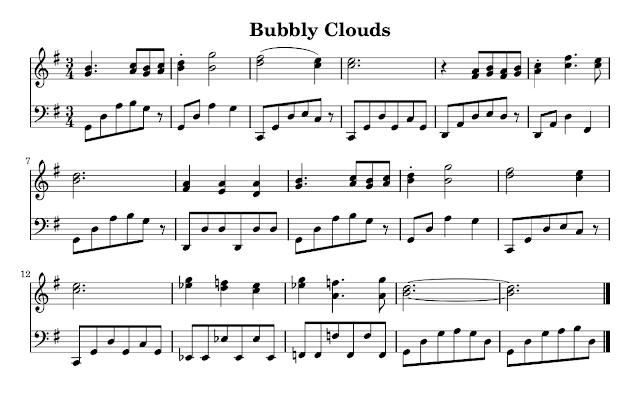Let's start out with a famous melody in 4/4, arguably one of the more well-known tunes from the Kirby canon, “Green Greens”. Here's the main theme:
 |
| Green Greens 'A' theme |
Flash Player
Even within such simple confines, the composers are already injecting real rhythmic interest by judiciously using triplets, conveying an intermittent swing feel. This is especially effective considering the unwavering eighth-notes in the accompaniment. The tune would still work if all the notes were played straight, but it'd probably lose much of its playfulness, and possibly be at risk of sounding a bit stilted. Those triplets make all the difference.
 |
| Green Greens 'B' theme |
Flash Player
And speaking of, in the approaching 'B' section the triplets cut loose and are all over the melody, adding further instances of rhythmic difference between the melody and the underlying groove, as well as a subtle contrast between the 'A' theme and the 'B' theme. If there's a lesson to be learned here, it's that rhythm is a powerful tool that can be used to add variety and logic to a piece.
Moving on to something in 3/4, let's take a slightly-more-in-depth look at “Bubbly Clouds” (remember, we'll come back to all of these tracks and really put them under the microscope in the future), another oldie from the first Kirby game that was dusted off for KSS. Here's a transcription of the 'A' section:
 |
| (Click to enlarge) |
Flash Player
Fairly uncomplicated stuff, you may say, and I agree for the most part. But, again, the composers put in deft touches that demonstrate useful compositional lessons. Check out the rhythm of the bass line as it does double duty, both by creating interest and unity by repeating rhythmic motifs throughout the section (and of course, defining the harmony), while in the same stroke, it provides the perfect contrast to the flowing legato melody by virtue of its more jumpy eighth-note driven nature. And, as we're beginning to expect of the composers, the 'B' section's bass line is an entire string of uninterrupted eighths as opposed to the more varied rhythms of the 'A' section, further distinguishing each section. Very cool.
Let's mix things up with a slightly more exotic time signature, check out Meta Knight's theme:
 |
| Ostinato from Meta Knight's Theme |
Flash Player
Here I've only notated the main bass line of the piece, which forms the backbone of the composition by repeating constantly—it's what's called an ostinato in classical lingo. This time instead of me transcribing and pointing things out, you give it a shot. Listen to the piece and pay attention to how each added element either conforms to the beat of the ostinato, or conversely, how some dance around it forming oppositional counter-rhythms. Also notice how the first note of the ostinato theme lasts two-and-a-half beats, rather than going the more obvious route of three whole beats, a choice that adds in some sweet syncopation. It shows that you can still add interest even within such a rigid framework.
Finally, to wrap this introduction up, let's talk about the “Revenge of Meta Knight Ending” theme, shall we? It's one of my favorite pieces in the game, and many's the time I clobbered Meta Knight just to hear it as a kid. Truly, we've saved the best for last. Here's a transcription of the main section:
 | ||
| (Click to enlarge) |
Flash Player
Tricky stuff. At first I thought the entire piece was in 12/8, not 4/4, but it's actually a little bit of both! I'd say this is a pretty early example of an extensive polyrhythmic section in a video game score. And not only that, but it's used toward great ends as a means of shaping the entire composition.
It's all thanks to an ingenious bit of rhythmic trickery; effectively, the entire rhythm section (notated in triplets, partially for convenience and partially to show the interrelationship between the two signatures a bit clearer)–from the drums, to the guitar arpeggios, to the organ stabs—is conspiring for you to hear this as purely 12/8, but listen as the trumpet line keeps planting the occasional seed of doubt. You can hear the foursquare melody pushing and pulling against the 12/8 feel, with periodic triplet licks aligning it with the groove, letting it slip into the rhythmic slot temporarily. It's an exciting and slightly disorientating feeling.
Then suddenly, just as we approach measure 9, everything starts locking together, easing the tension by finally allowing both the melody and the rhythm section to mesh completely and creating an energizing and furious pull into the organ solo. This is a fantastic example of how you can not only create diversity and direction between sections tonally, but rhythmically too. Wisely, the composers choose to keep the momentum flowing by keeping the organ solo almost entirely in the 12/8 feel. We'll get to the 'B' section in due time, but until then may I just say that that's a damn fine organ solo.
And so we come to a close, at least for now. I hope you learned something from this, even if it was just the names of a couple of cool tunes to drop into your playlist. Next time we'll really start digging deep, as we begin the process of dissecting entire pieces and seeing all they have to show us rhythmically, harmonically, and beyond.
Big thanks to the guys at SNESMusic.org for all their hard work cataloging and preserving SNES music, and the LilyPond team for creating the incredible sheet music engraver used throughout this article.
_______________

No comments:
Post a Comment